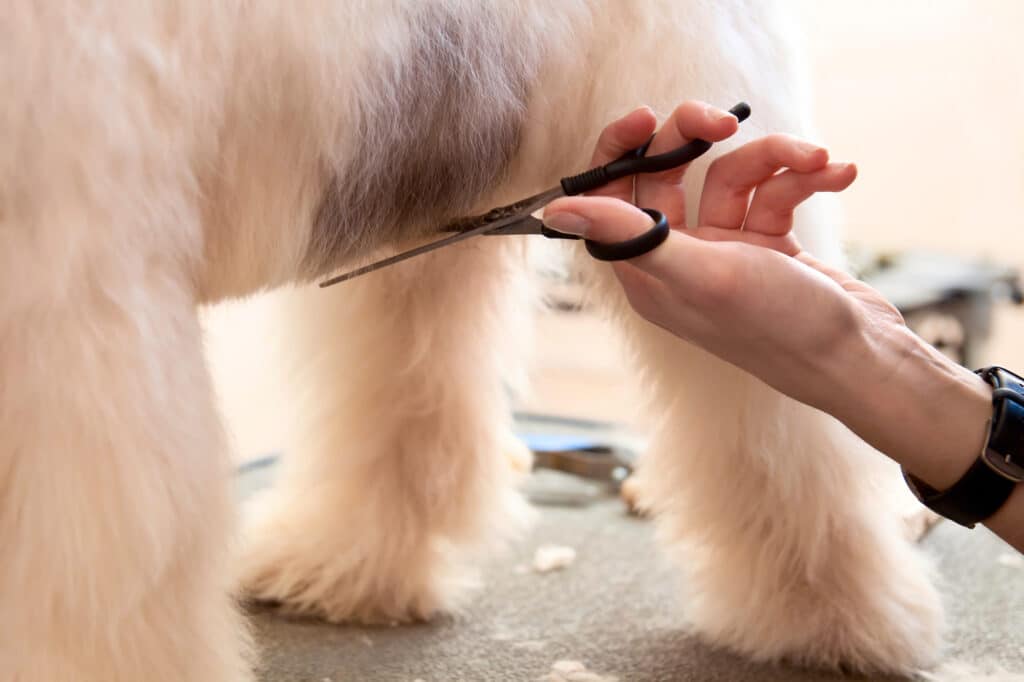
A sanitary trim, also known as a hygiene trim, is a grooming procedure performed on dogs to maintain cleanliness and prevent any discomfort or health issues related to the hair around their sensitive areas. This procedure involves trimming the hair on the dog’s genitals, anus, and underside to keep them clean and free of any unwanted debris or matting. Sanitary trims are often done in conjunction with regular dog grooming sessions or as needed.
Importance of Sanitary Trims
Dogs, just like humans, require proper hygiene to stay healthy and comfortable. Certain breeds, such as poodles and other long-haired dogs, are more prone to hair matting, especially around their private areas. Matting can lead to skin irritation, bacterial or fungal infections, and an unpleasant odor. By regularly performing a sanitary trim on your dog, you can prevent these issues from occurring and maintain their overall well-being.
1. Preventing Infections:
Dogs’ genitals and anus are susceptible areas where dirt, fecal matter, or urine can accumulate, leading to potential infections. Trimming the hair in these areas is essential to minimize the risk of bacteria or parasites gaining a foothold. Sanitary trims help to keep this area clean and protect against urinary tract infections, vaginitis, or urinary stones.
2. Avoiding Matting:
When hair around the dog’s private areas is left untrimmed, it can tangle and form mats. Mats can be uncomfortable for dogs and often lead to skin irritation or painful pulling on the skin. Sanitary trims ensure that the hair in these areas remains free from tangles and matting, providing comfort and preventing any associated skin problems.
3. Reducing Odor:
Untrimmed hair around the genitals and anus can trap odor-causing substances, including urine and feces. A build-up of these substances can generate an unpleasant smell that not only affects the dog but also the entire household. Regular sanitary trims eliminate this odor-trapping hair and help keep your dog smelling fresh.
4. Maintaining Hygiene during Heat Cycles:
Sanitary trims are particularly important for female dogs during their heat cycles. Without proper grooming, the discharge from the vaginal area can get trapped in the hair, leading to discomfort, infection, or even attracting unwanted pests like flies. Trimming the hair around the vulva helps keep the area clean and prevents any associated issues.
The Sanitary Trim Process
Performing a sanitary trim on a dog requires precision, attention to detail, and the right tools. While it can be done at home, many owners prefer to have it done by a professional groomer to ensure proper technique and reduce the risk of injury. Here’s a step-by-step breakdown of the process:
1. Preparation:
Before starting the sanitary trim, it is crucial to prepare the dog. This may involve brushing out any tangles or mats around the genital area to make the process easier. Additionally, it is crucial to have treats on hand to reward your dog for staying calm and cooperative during the grooming session.
2. Identifying the Trim Areas:
The areas that require trimming may vary depending on the dog’s gender and hair coat. In general, these areas include the hair around the genitals, anus, and underside. It is essential to locate and identify these regions to maintain accuracy during the trimming process.
3. Trimming:
The actual trimming process involves using grooming shears or clippers specifically designed for use on dogs. It is important to use sharp, clean blades to achieve a clean and precise trim. Care must be taken not to cut the skin or cause any unnecessary pain to the dog during this process.
4. Removing Excess Hair:
Once the hair is trimmed, any loose or excess hair should be gently removed to further ensure cleanliness. This can be done using a comb or brush specifically designed for removing loose hair.
5. Post-Trim Care:
After the sanitary trim, it is essential to reward your dog with praise and treats for their cooperation. It is also advisable to keep an eye on the trimmed areas for any signs of redness, irritation, or infection.
When to Perform a Sanitary Trim
The frequency of performing a sanitary trim depends on factors such as the dog’s breed, hair type, and grooming routine. Some dogs may require more frequent trims, while others may only need it occasionally. However, there are a few signs that indicate a sanitary trim may be necessary:
1. Matting or Tangles:
If you notice any matting or tangles around the dog’s genitals or anus, it is a clear indication that a sanitary trim is needed. Matting can lead to discomfort and increase the risk of infection if left unattended.
2. Foul Odor:
A strong, unpleasant smell around the dog’s private areas can be an indicator of accumulated debris or infection. Regular sanitary trims can help eliminate or reduce the odor.
3. Difficulty in Cleaning:
If you find it challenging to clean the dog’s private areas due to excessive hair, it is time for a sanitary trim. A clean area is essential to maintain good hygiene and prevent any associated health issues.
4. Heat Cycles in Female Dogs:
Female dogs require extra attention during their heat cycles. Trimming the hair around the vulva can help prevent discharge from getting trapped in the hair and reduce the risk of infections.
While these signs can help determine when a sanitary trim is necessary, it is always recommended to consult a professional groomer for guidance and assistance.
Read: Trimming Dog Ear Hair: Ear Trimming FAQs
Potential Risks and Considerations
Performing a sanitary trim requires care and precision to avoid any potential risks or complications. Here are a few considerations to keep in mind:
1. Injury Risks:
Grooming tools, such as shears or clippers, can accidentally injure the dog if not handled correctly. It is essential to use the proper tools and techniques to minimize the risk of accidental cuts or nicks.
2. Skin Irritation:
Dogs with sensitive skin may experience irritation or redness after a sanitary trim. This can be caused by the sharpness of the blades used or the overall grooming process. If you notice any signs of irritation, consult your veterinarian for appropriate treatment.
3. Behavioral Reactions:
Some dogs may become anxious, stressed, or uncomfortable during the grooming process. It is vital to ensure a calm and positive environment to minimize any potential behavioral issues. Patience, treats, and breaks, if necessary, can help make the grooming experience more comfortable for your dog.
4. Professional Assistance:
If you are unsure about performing a sanitary trim at home, or if your dog has a particularly thick or difficult coat, it is advisable to seek professional assistance. Professional groomers have the expertise and experience to safely and effectively perform a sanitary trim, reducing the risk of accidents or complications.
In conclusion, a sanitary trim is a grooming procedure essential for maintaining a dog’s hygiene and overall well-being. By regularly trimming the hair around the genitals, anus, and underside, owners can prevent infections, matting, odor, and discomfort. However, it is crucial to exercise caution, seek professional assistance if needed, and prioritize the safety and comfort of the dog during the grooming process. With proper care and attention, a sanitary trim can be an effective tool in keeping dogs clean, healthy, and happy.


